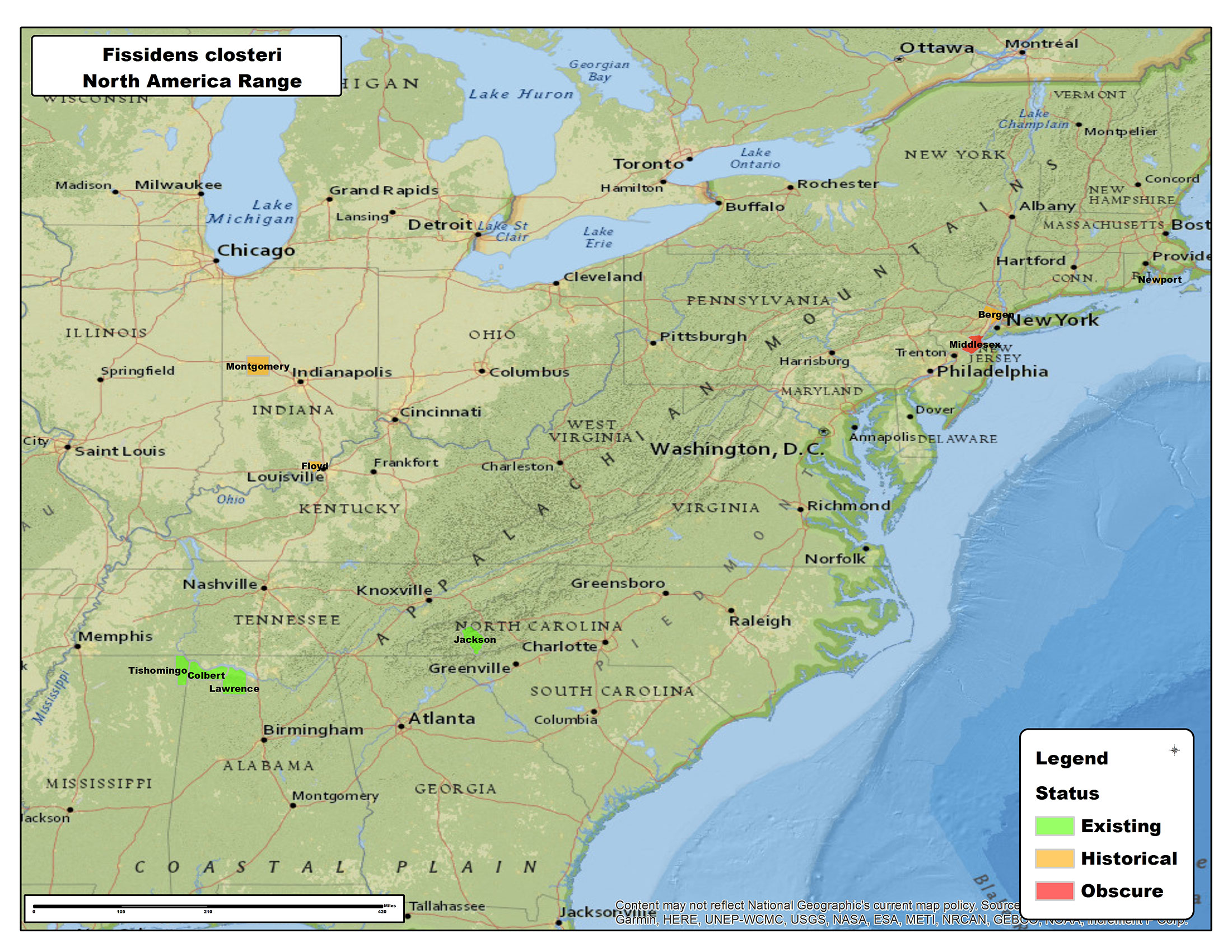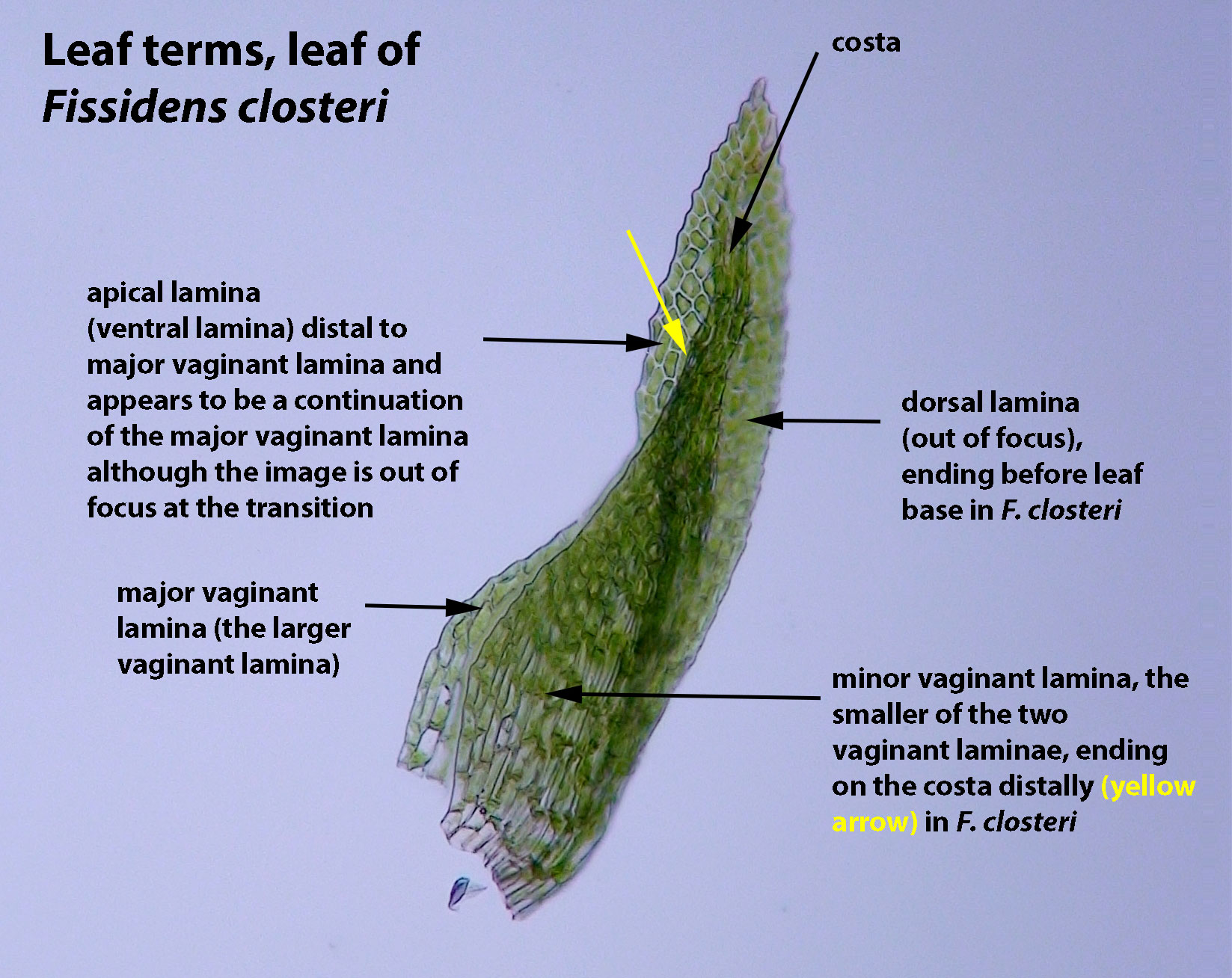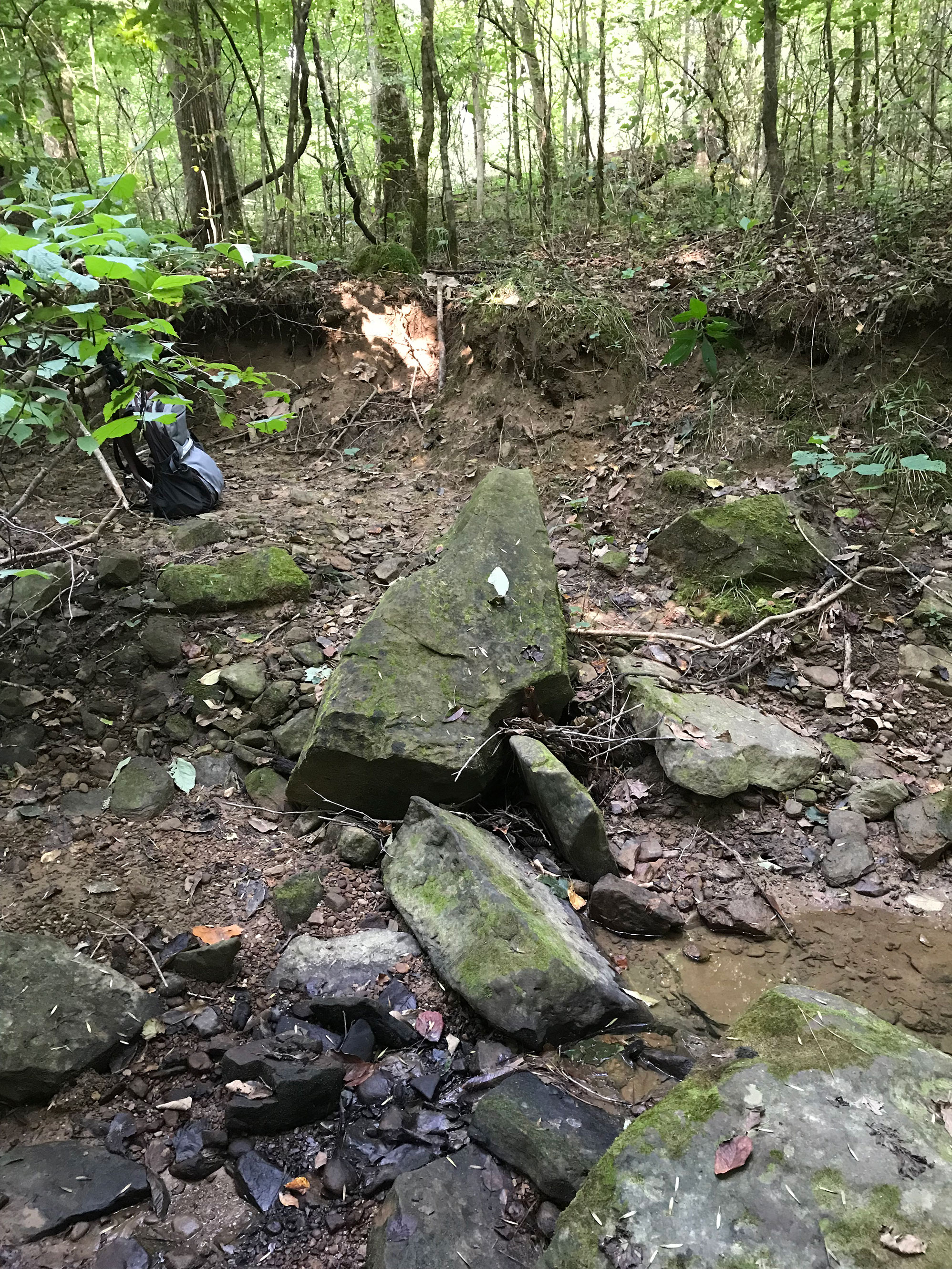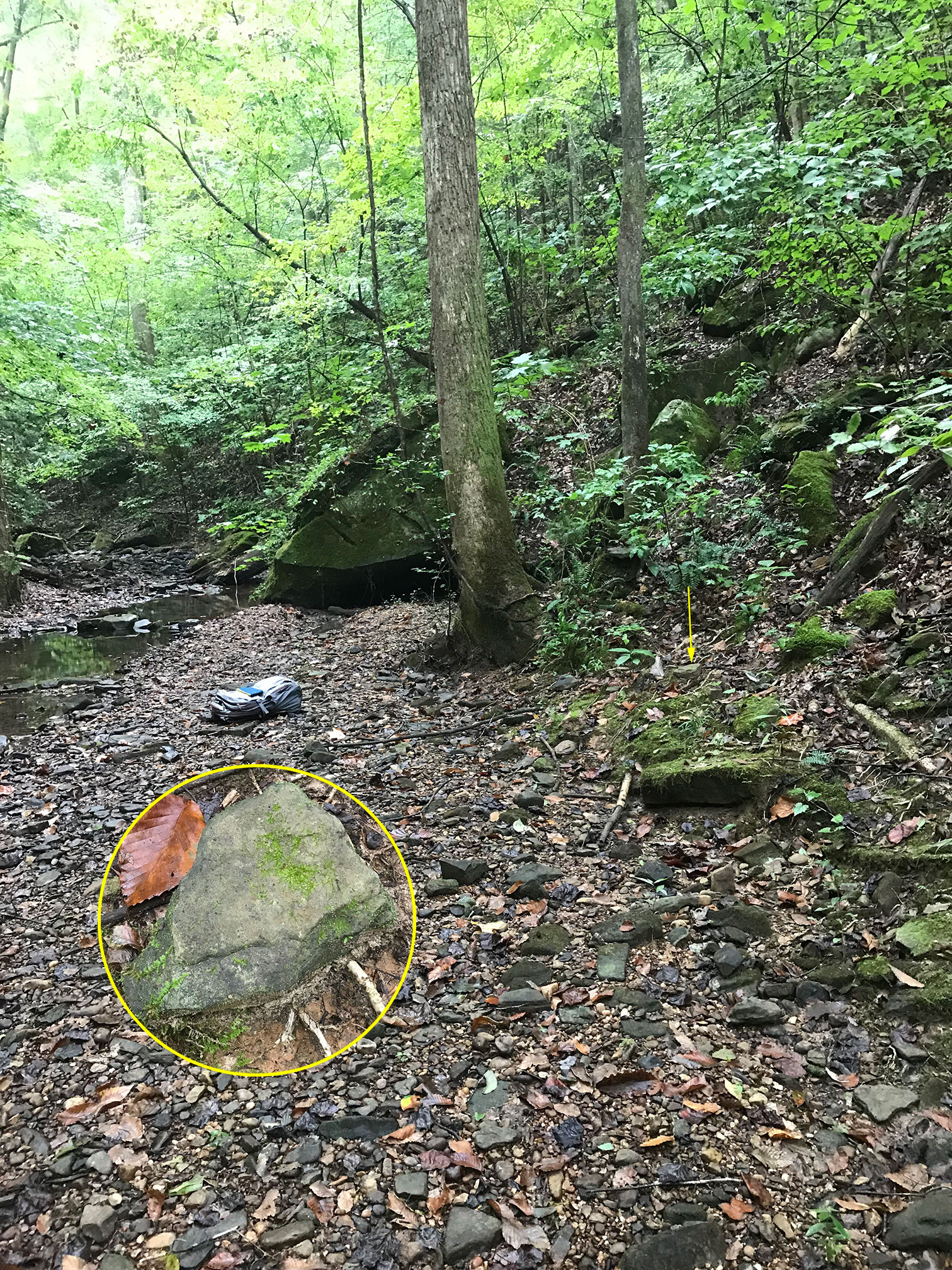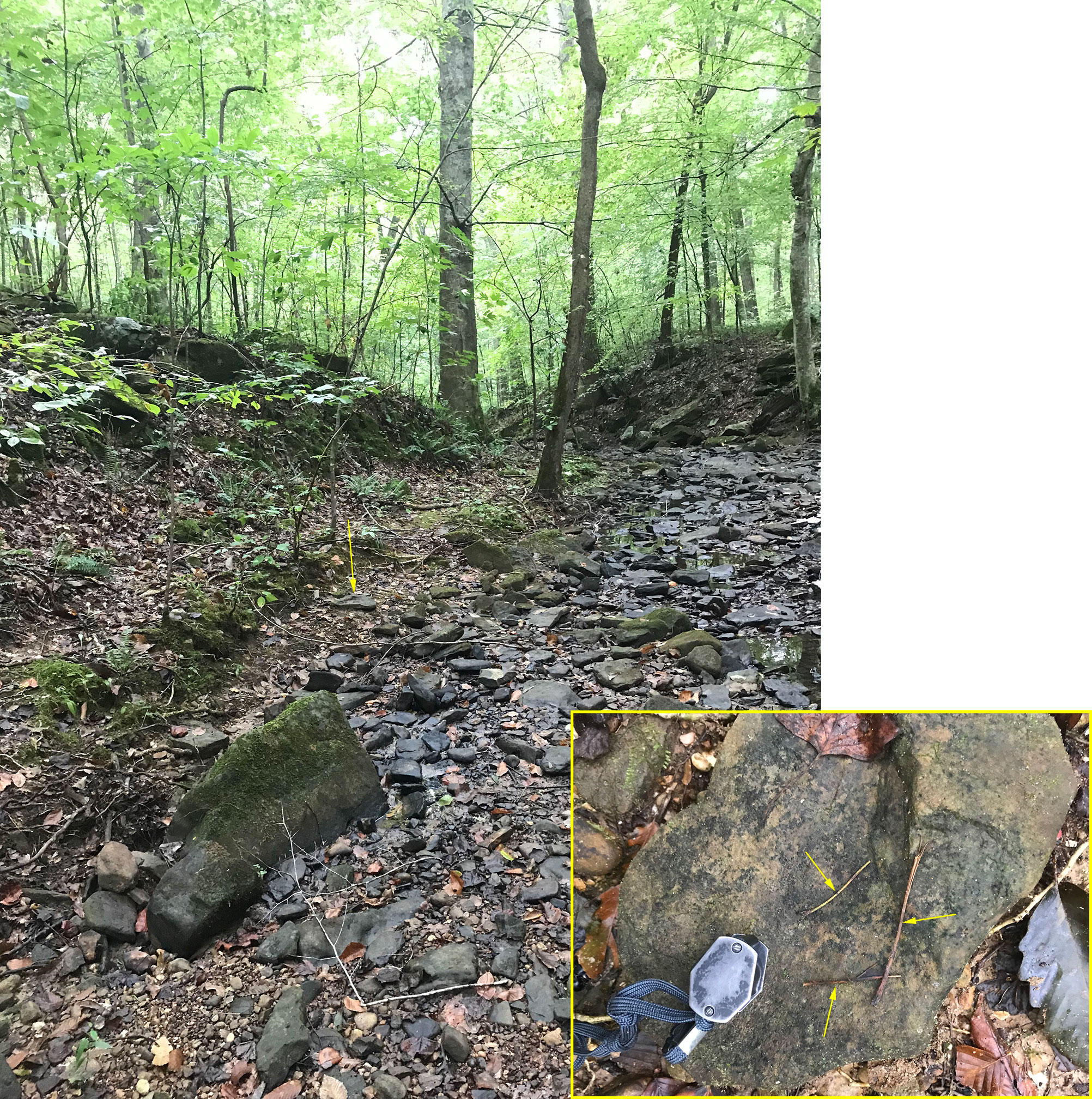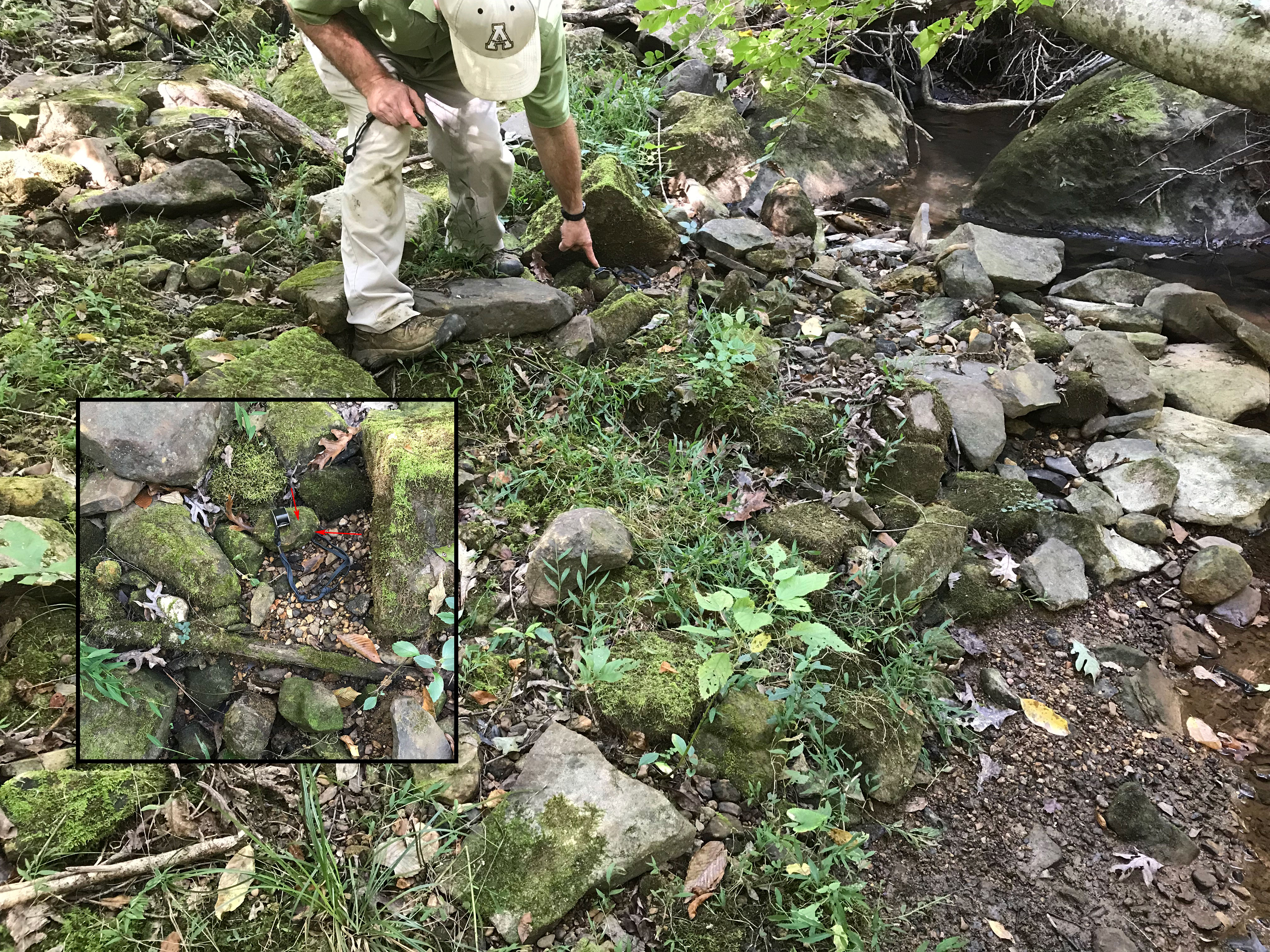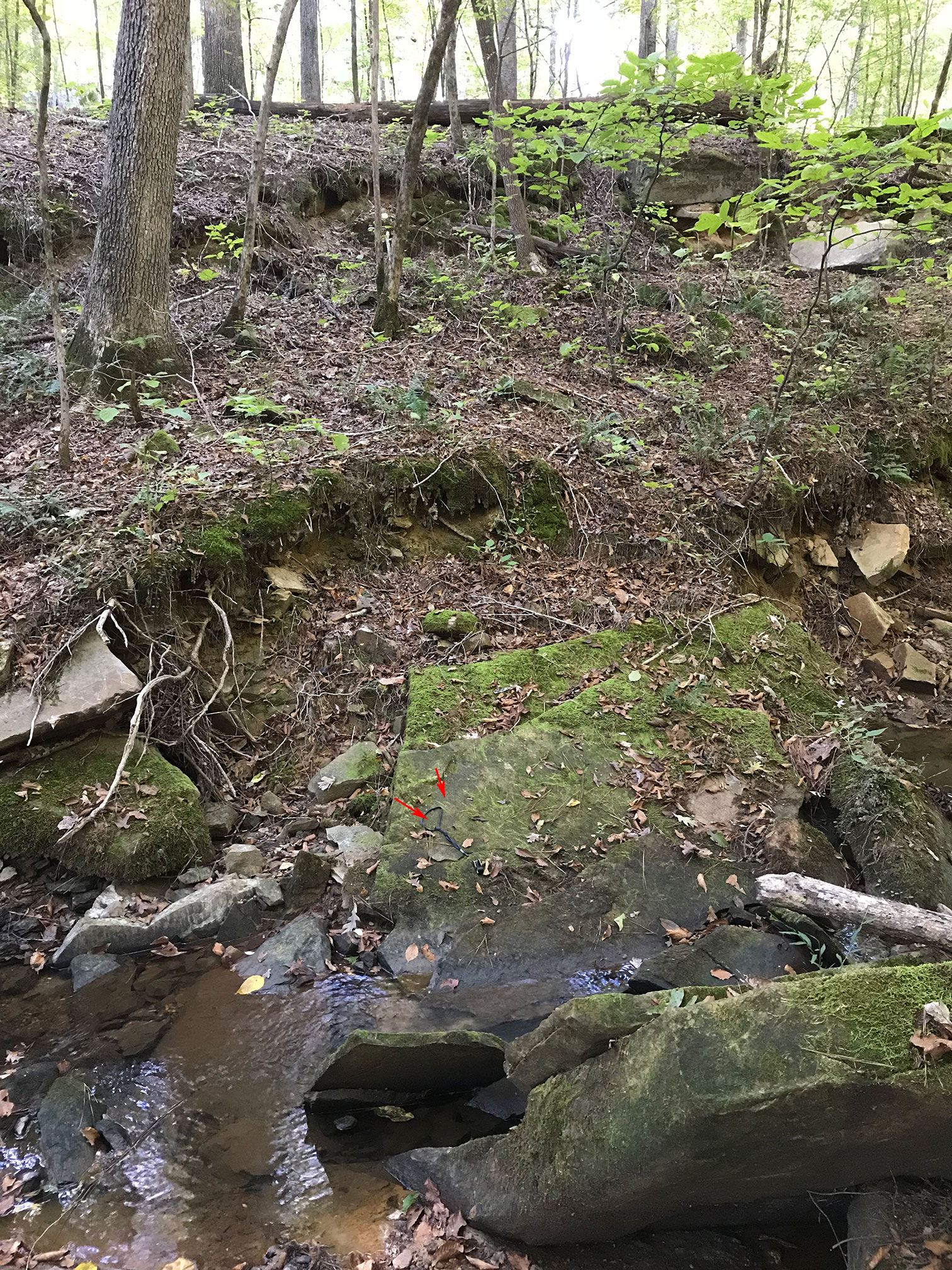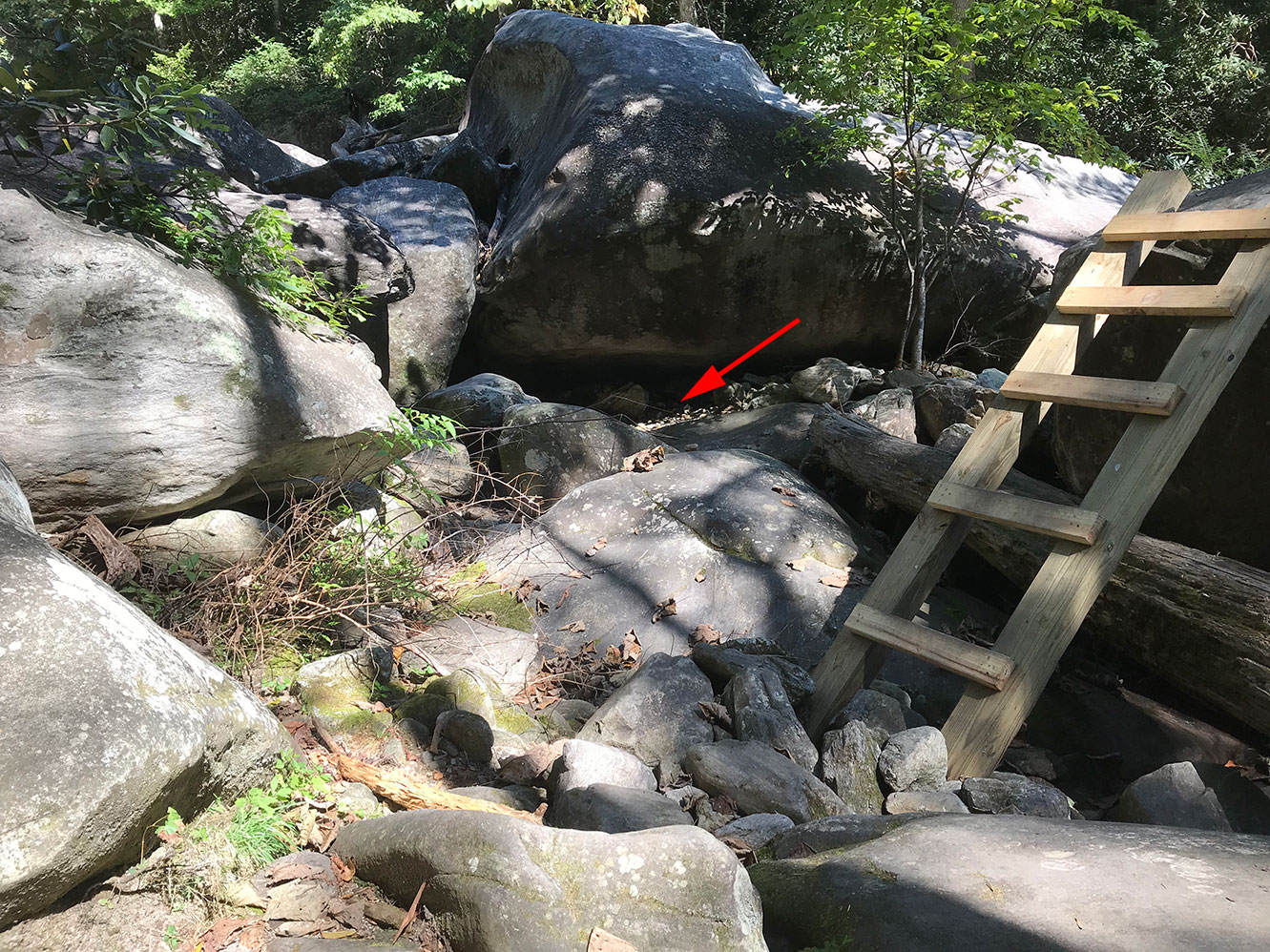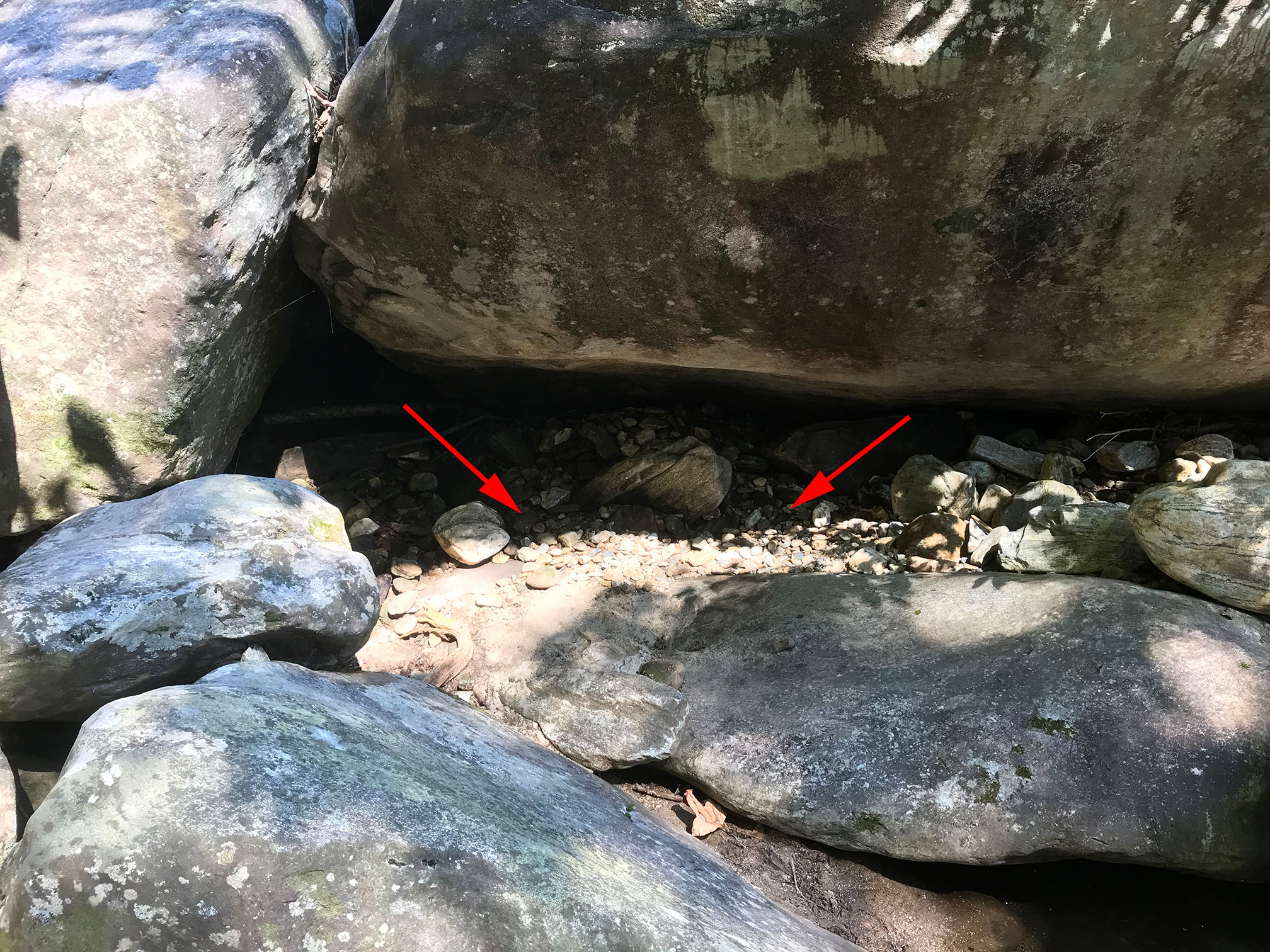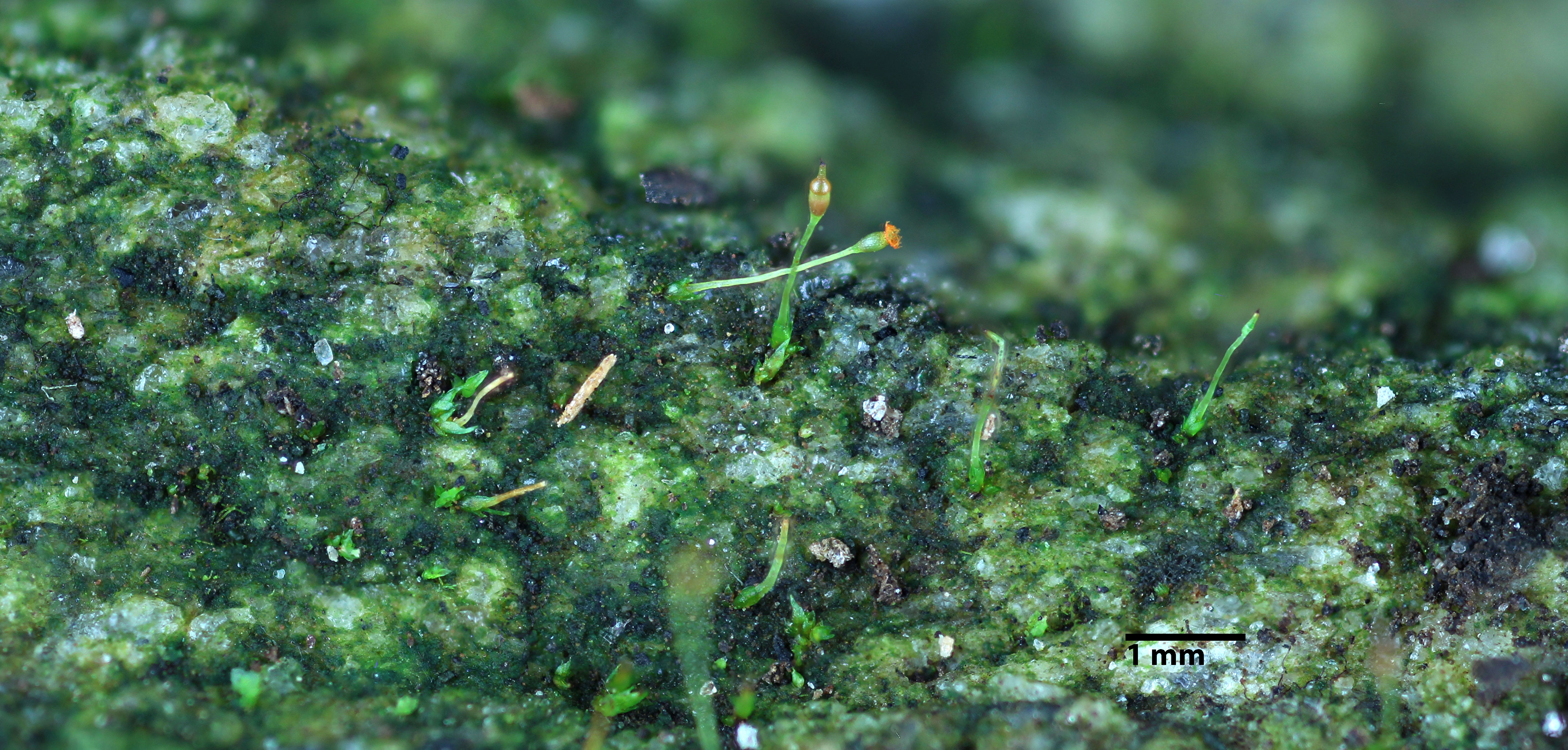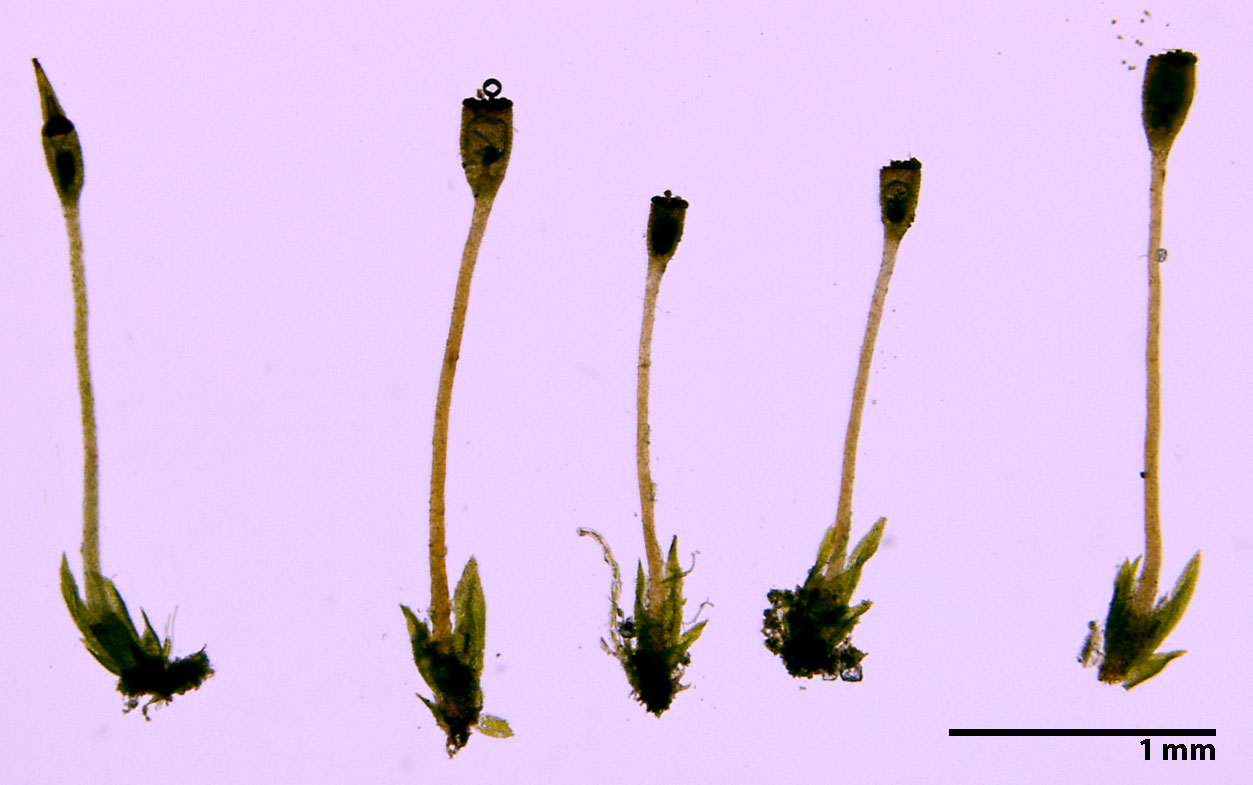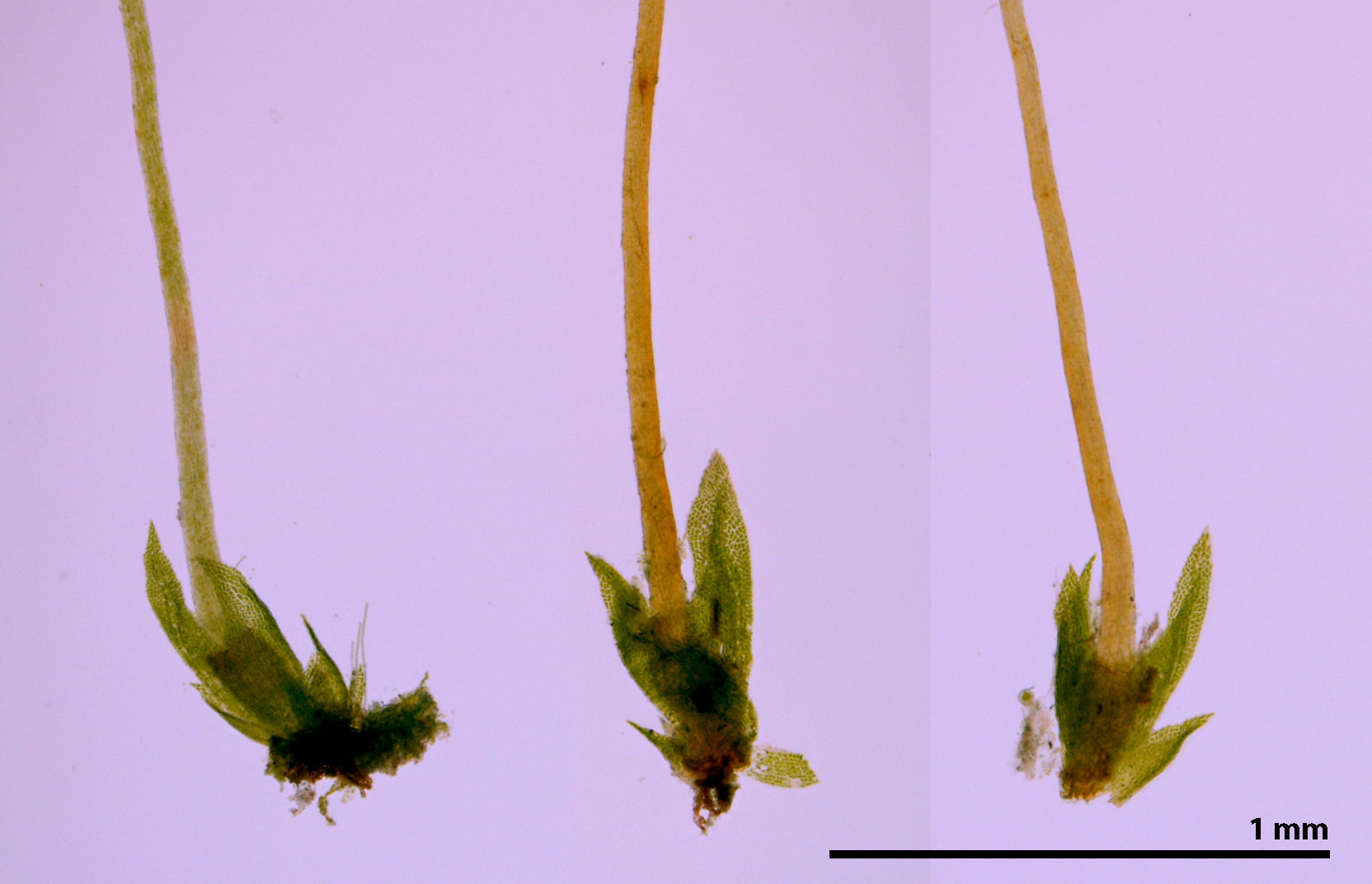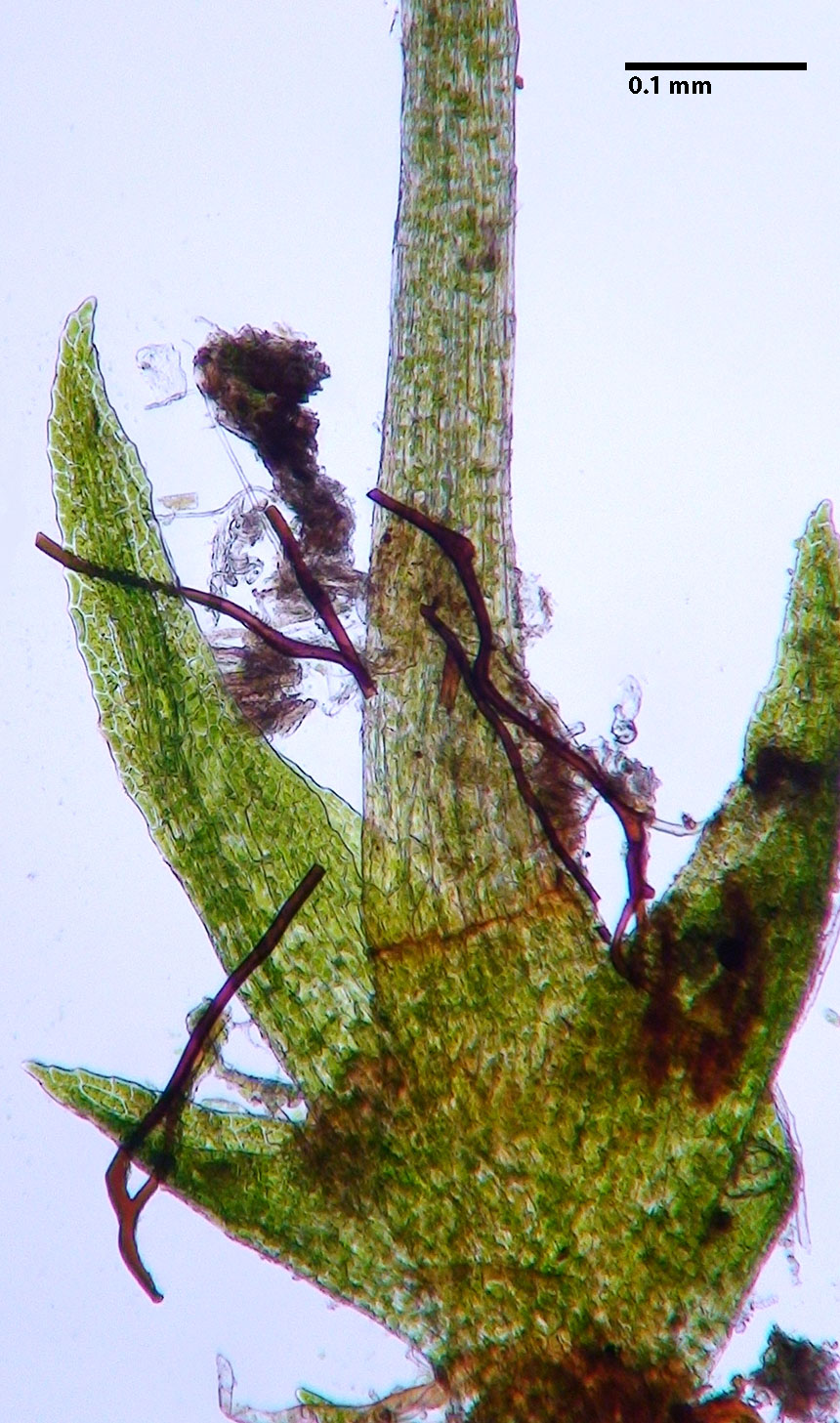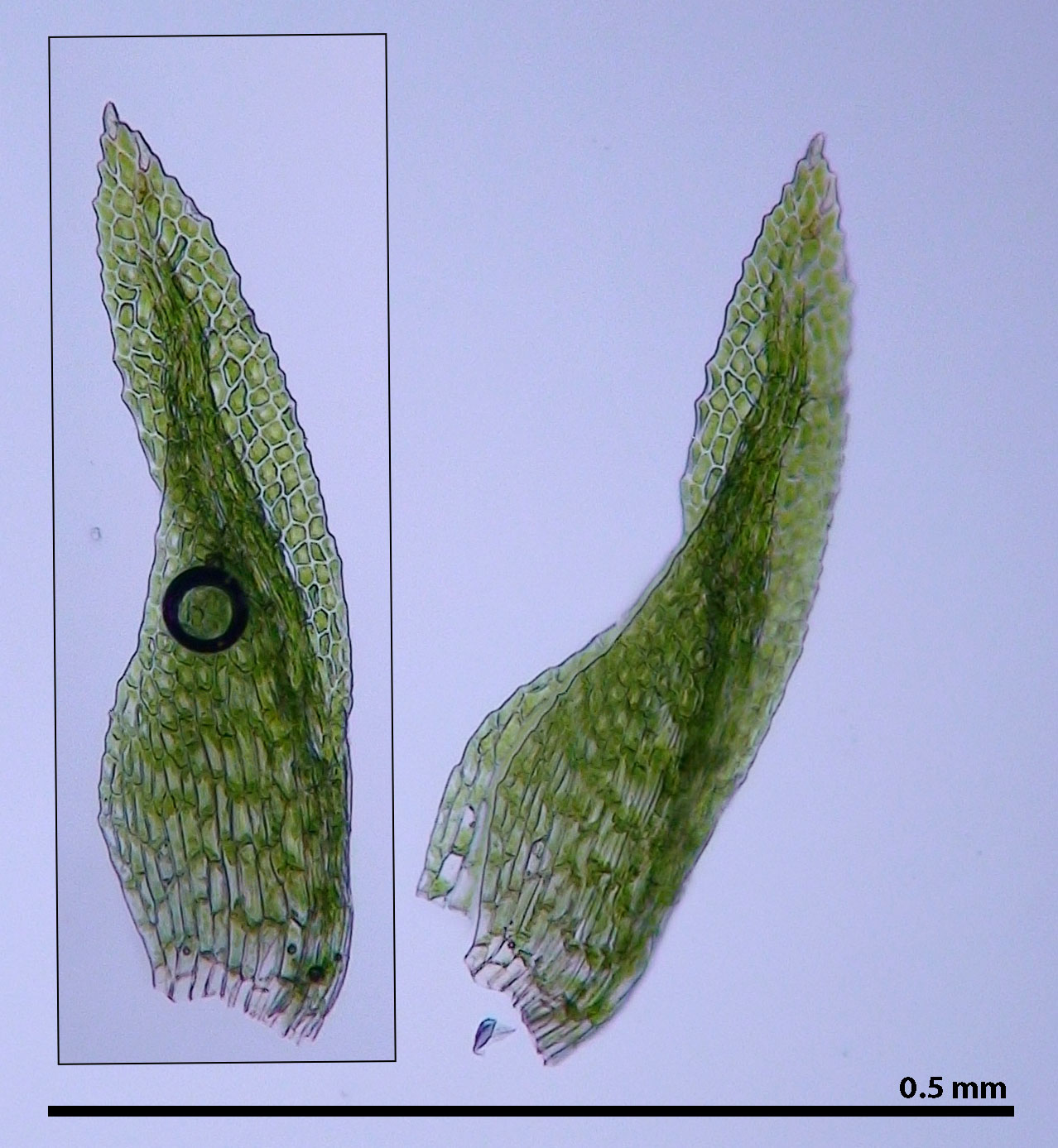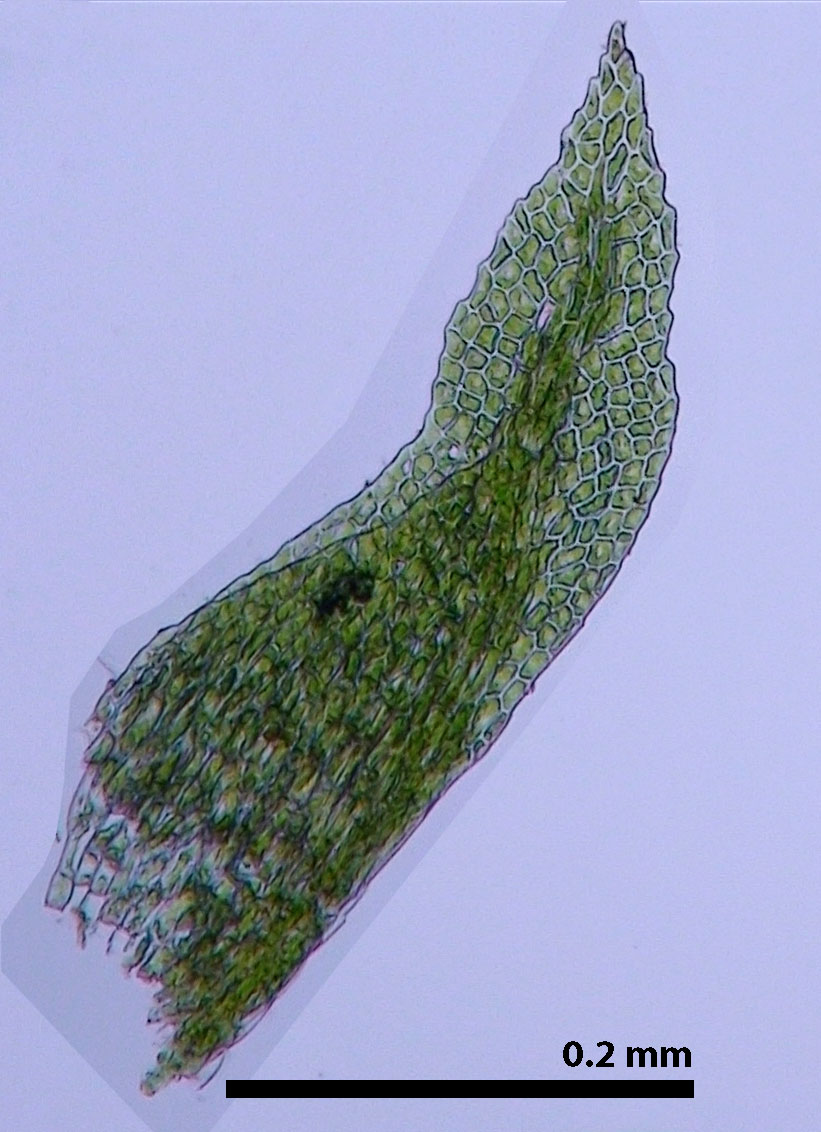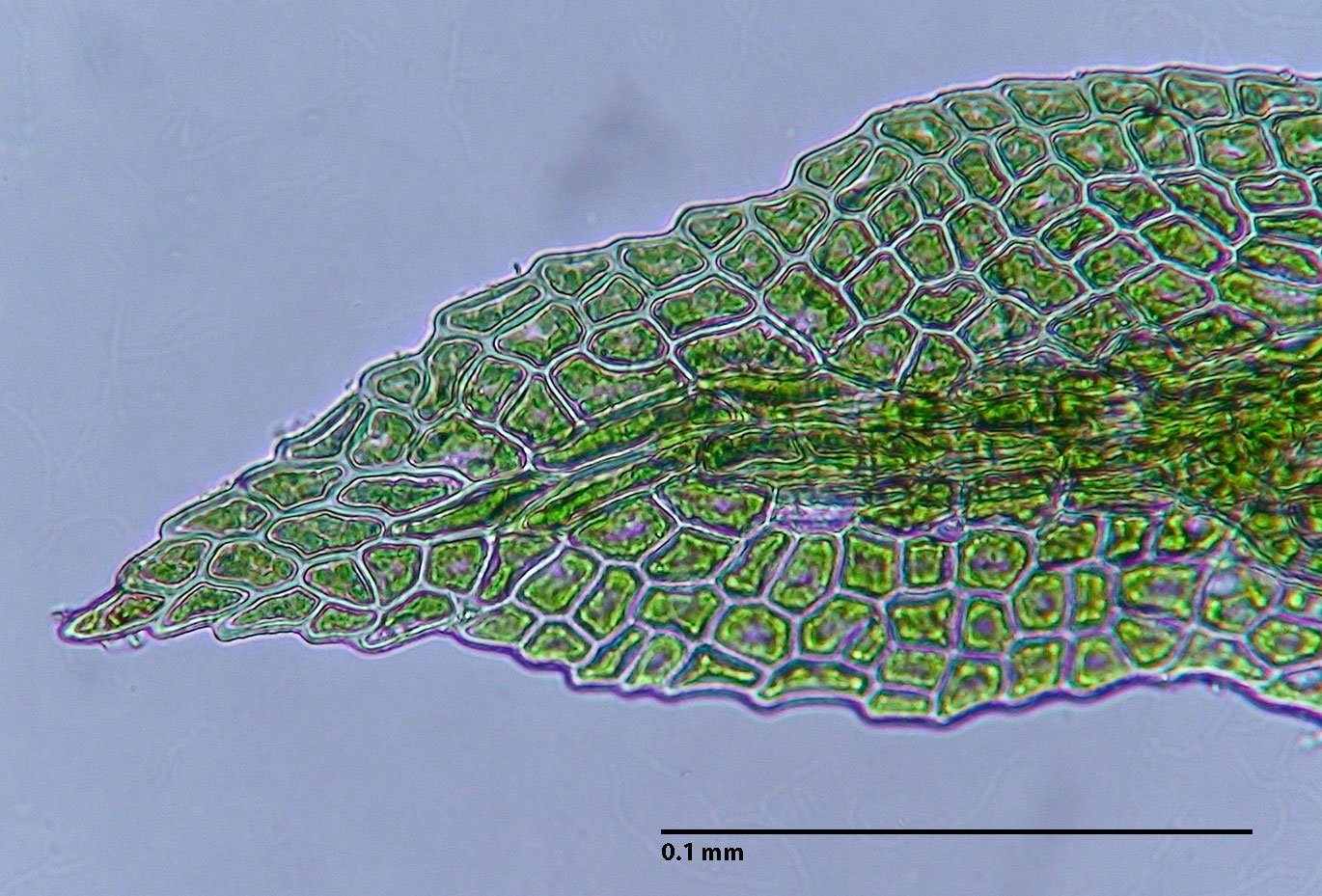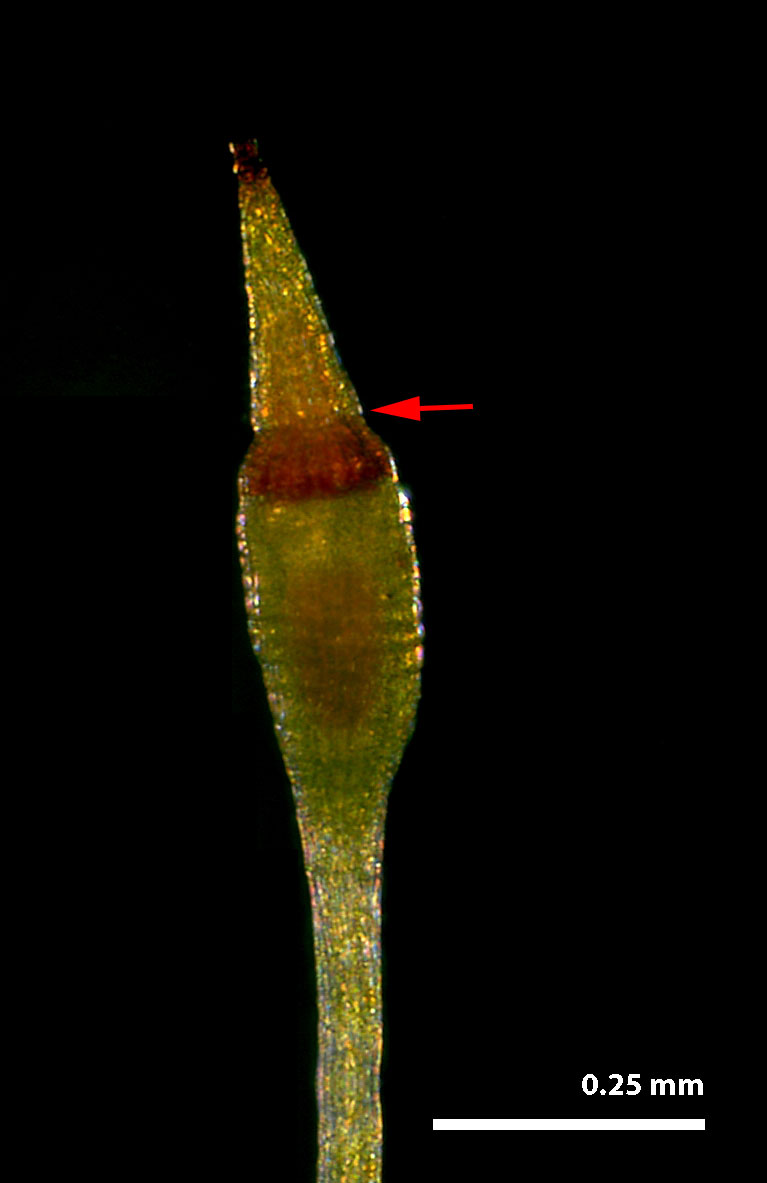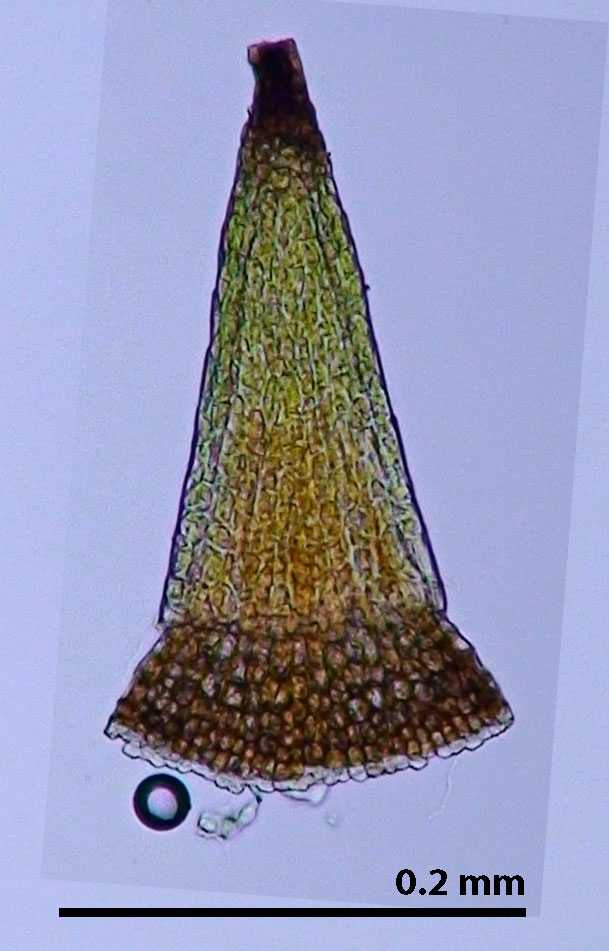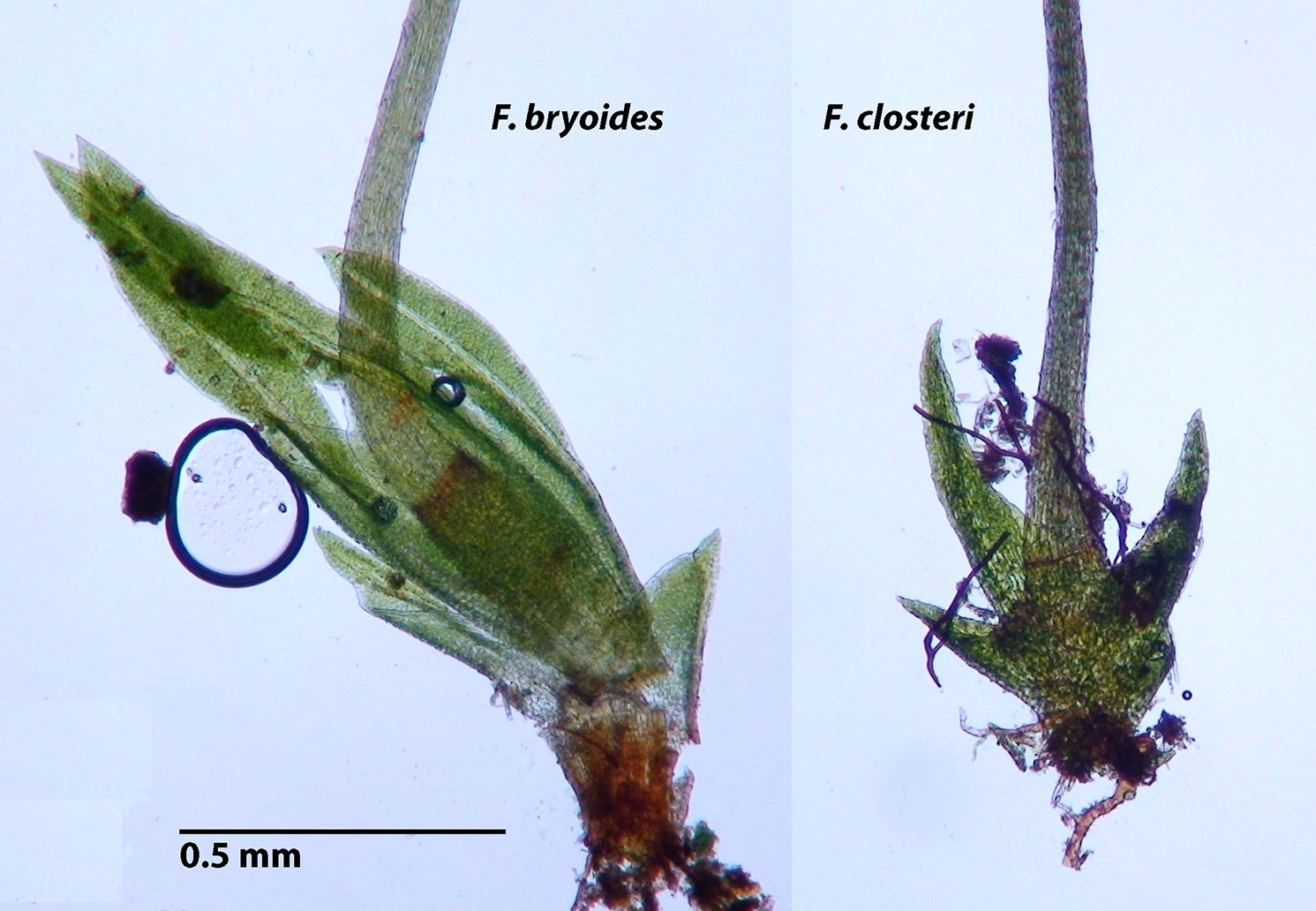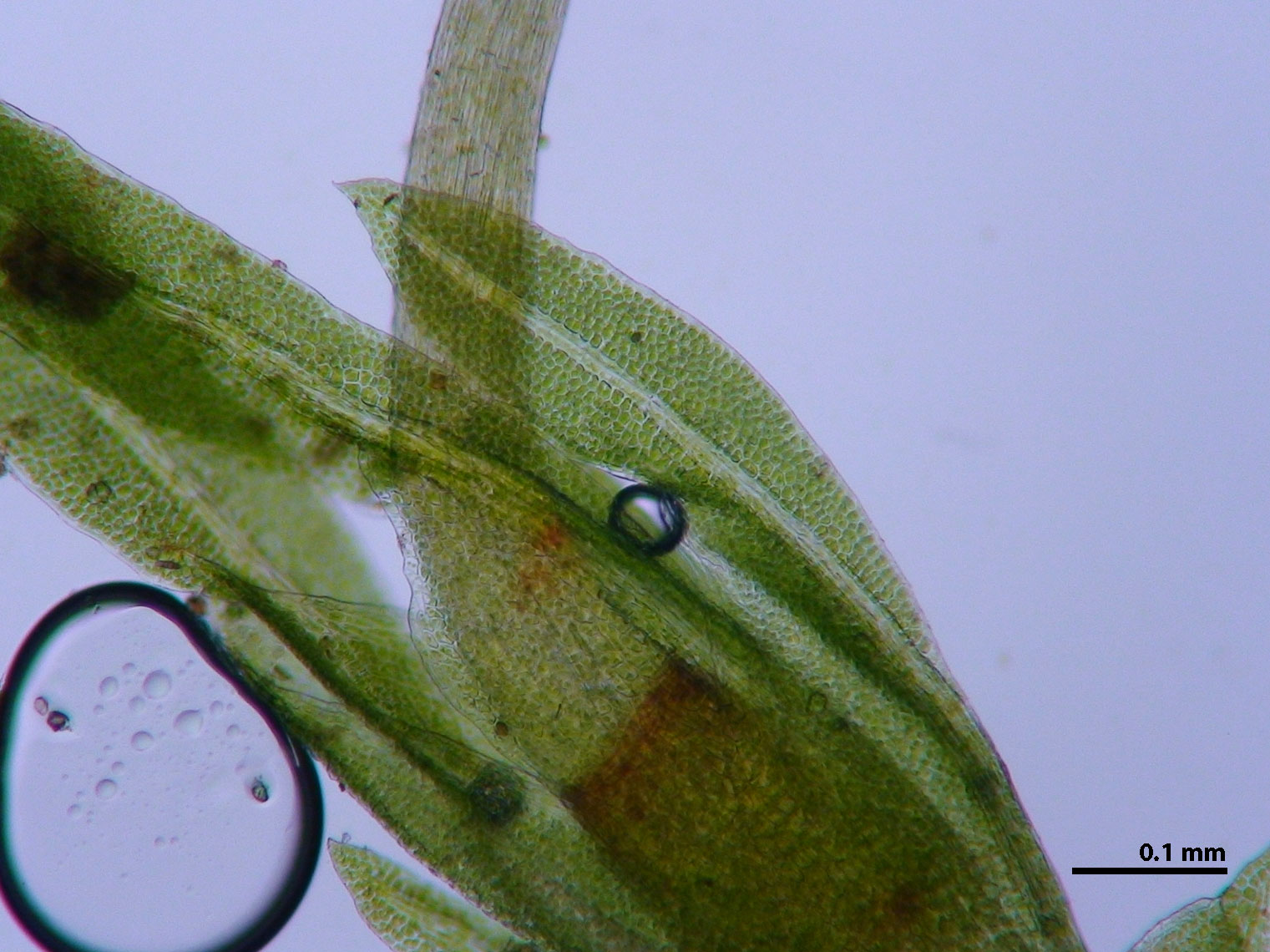Fissidens closteri Austin subsp. closteri
Family: Fissidentaceae
Synonyms
none
NatureServe Conservation Status
G2? TNR
Special Terms for Leaves of Fissidens
For image below, the stem would be left of leaf, shoot apex towards top of image.
Distribution
Endemic to eastern U.S.A. Alabama, Indiana, Mississippi, New Jersey, North Carolina, Rhode Island. Fissidens closteri subsp. kiusiuensis occurs in Asia: China, Japan, Thailand (Printarakul et al. 2014).
Pursell (2007, p. 357) stated, "It is probably more abundant than its distribution reflects but goes unnoticed because of its tiny size." The discovery of F. closteri in Alabama (Bankhead Nat'l Forest) was made on August 24, 2018. Based on verified specimens the species hadn't been seen in North America since 1939. Realizing that, 1) F. closteri can't be seen in its natural habitat without a hand lens, and 2) the habitat is not uncommon, by October 12, 2018 we had records for Mississippi and North Carolina.
Habitat
Forested stream ravines, on rock: sandstone (cobblestone size and larger) in Alabama and Mississippi; crevices of decomposing rock in Indiana (Welch 1941); a large flat stone in Rhode Island (Handy 1909); on stones along woodland rivulets in New Jersey (Austin 1874); low elevations (less than 100 ft - 2200 ft). "Rocks along streams in woods, probably subject to flooding" (Pursell 2007, p. 357).
The populations in the Southeastern U.S. appear to be confined to rock along banks of streams where inundation is limited to flash flooding. At the Alabama, Mississippi, and North Carolina sites, F. closteri often occurred with Fissidens bryoides on the same rock but generally not commingled.
The Asiatic Fissidens closteri subsp. kiusiuensis occurs on soil (Li and Iwatsuki 2001; Kamiyama et al. 2013).
Brief Description and Tips for Identification
Plants minute, budlike, nearly stemless. Leaves up to 0.4 to 0.75 mm long, margin not bordered by linear cells, dorsal lamina ending above the leaf base, minor vaginant lamina narrowed distally and ending on the costa, costa ending 2 to 3 cells below the apex. Description modified from Crum and Anderson (1981) and Pursell (2007).
Monoicous. Rhizautoicous, i.e. "androecium on a very short branch attached to the female stem by rhizoids and appearing to be a separate plant" (Tropicos Bryophyte Glossary). Seta 1 - 2.5 mm long. Capsule erect. Calyptra mitrate, smooth.
A hand lens is essential in the search for Fissidens closteri, otherwise the species is "invisible to the naked eye (in its native ravines) except with the aid of a strong and favorable light" (Austin 1874, p. 22). It appears that all reliably identified specimens were collected in the months July through October. Collectors first see the sporophytes whose setae appear to arise directly from the rock's surface. By focusing on the rock's surface, a green "bud" formed of a few imbricate leaves may be seen at the base of a seta. It is unlikely the species can be found when sporophytes are not present.
Salient Features
- For all practical purposes, detectable in its natural habitat only with the aid of a hand lens.
- Green gametophyte budlike at the base of the seta.
- Leaf margin without differentiated border of elongate cells.
- The smallest Fissidens in North America (Pursell 2007).
References
Austin, C. F. 1874. On some new North American Musci. Bulletin of the Torrey Botanical Club, 5(5), 21-24.
Crum, H. A., and L. E. Anderson. 1981. Mosses of Eastern North America (Vol. 1). Columbia University Press.
Handy, L. H. 1909. A Second Station for Fissidens Closteri. The Bryologist, 12(1), 9-9.
Kamiyama, T., T. Suzuki and Z. Iwatsuki. 2013. Fissidens in Tochigi-ken, Honshu, Japan. Hattoria 4: 119-135.
Li Z-H. and Iwatsuki Z. 2001. Fissidentaceae.,Pp. 3–67 in: Li X-J, Crosby MR (eds) Moss Flora of China, volume 2.
Printarakul, N., Tan, B. C., Wongkuna-Thananoppakun, K., and Santanachote, K. 2014. The Indian connection of the Thailand moss flora, with one new species, Fissidens elizbrowniae. Telopea, 17, 195-215.
Pursell, R. A. 2007. Fissidentaceae. In: Flora of North America, North of Mexico 27: 331-357.
Sullivant, W. S. 1874. Icones Muscorum or figures and descriptions of most of the mosses peculiar to eastern North America which have not been yet been figured. Supplement. C. W. Sever, Cambridge, MA.
Welch, W. H. 1941. Studies in Indiana Bryophytes IV. In Proceedings of the Indiana Academy of Science (Vol. 51, pp. 103-113)
Habitat
Habitat
Habitat
Habit
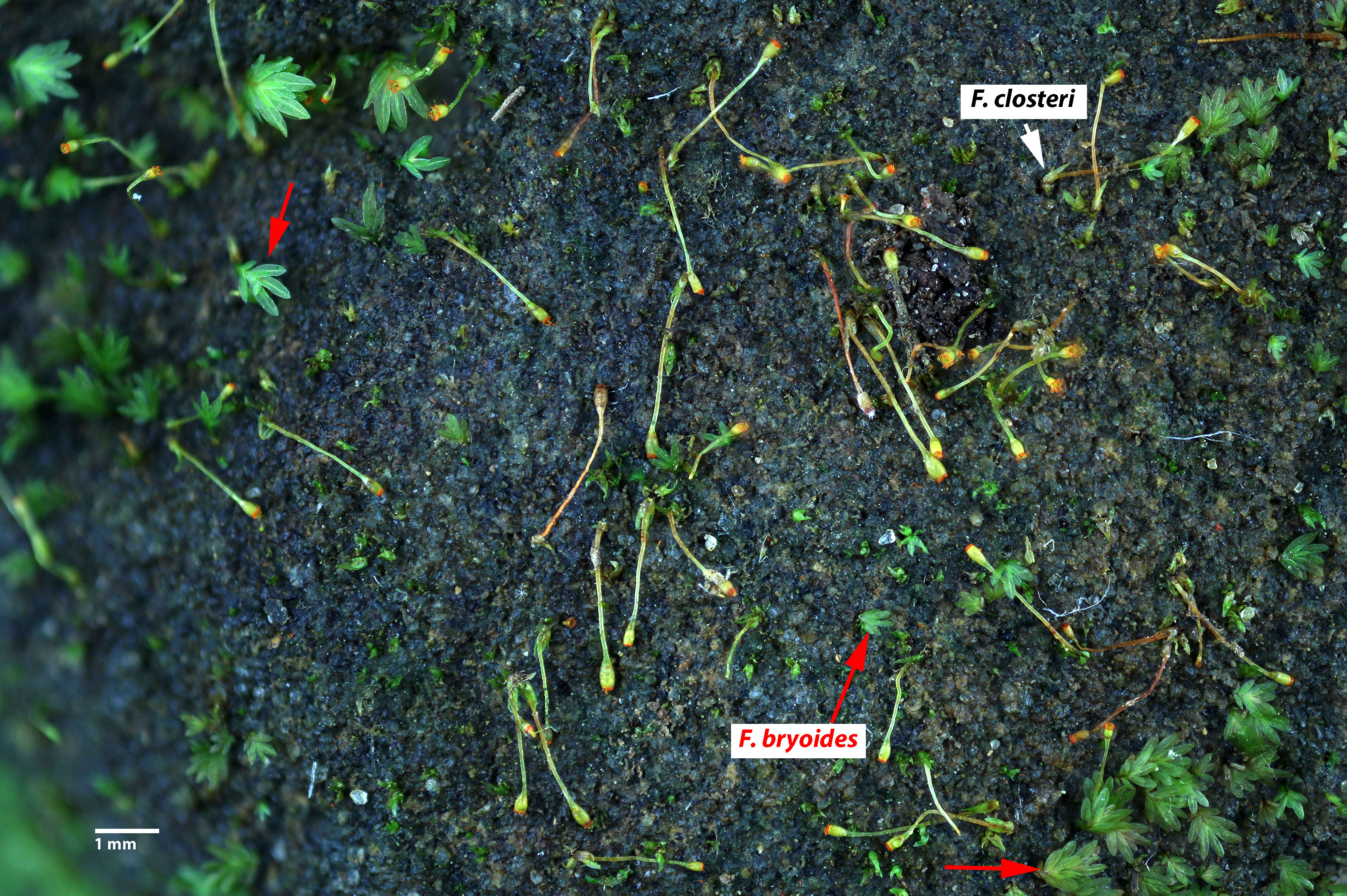
Fissidens closteri
The stone whose upper surface supported the plants in the photo would fit nicely in the palm of your hand as a throwing stone. Many of the sporophytes of F. closteri were pressed horizontally by the collecting bag. Red arrows indicate small expressions of the common Fissidens bryoides.
